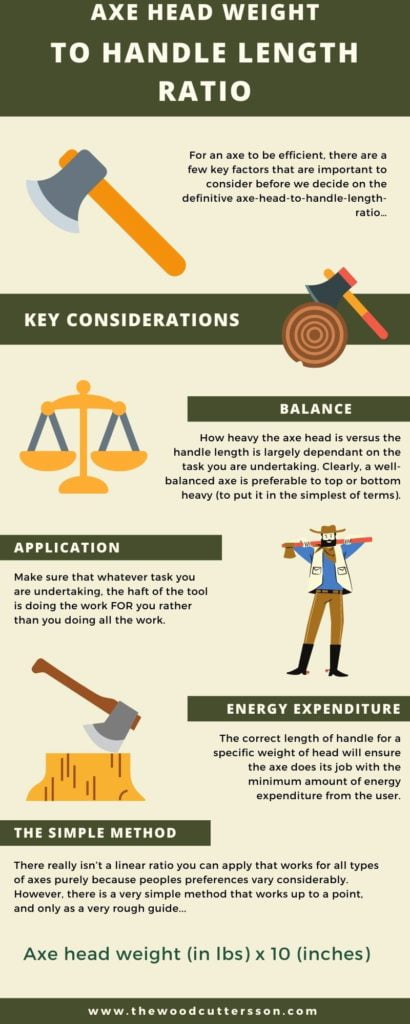For an axe to be efficient, there are a few key factors that are important to consider before we decide on the definitive axe-head-to-handle-length-ratio…
How heavy the axe head is versus the handle length is largely dependant on the task you are undertaking. Clearly, a well-balanced axe is preferable to top or bottom heavy (to put it in the simplest of terms).
Whenever possible, you want to make sure that whatever task you are undertaking, the haft of the tool is doing the work FOR you rather than you doing all the work.
The correct length of handle for a specific weight of head will ensure the axe does its job with the minimum amount of energy expenditure from the user.
TABLE OF CONTENTS:
Basic Axe Applications
Felling huge trees with an axe for example, requires a long curved handle to deliver maximum power generation to cut deep into that sucker quickly. 36 inches is often cited as ideal for this purpose, with a head weight of over 3 lbs – but it would depend on the size of the user as well.
What works for a strapping 6′ 5″ lumberjack may not be the most efficient choice for someone say, 5′ 10″ tall of slim build. The aim is to have a tool that can be used comfortably and safely for an extended period of time.
Splitting logs is also much more efficient with a 6 lb splitting axe or maul on a 36in handle. But again not everyone can swing one of those bad boys.
Related Article: Top 10 best-rated splitting axes – reviews and buyers guide
Camping and bushcraft axes require an entirely different beast. Smaller hatchets or pack axes should be lighter, portable, with more emphasis on a razor sharp cutting edge rather than an ‘ideal’ head weight to handle length ratio.
A 2 lb pack axe sits nicely on a 24″ handle for most, some camp hatchets have 14″ handles that are pretty useless for any serious chopping. But that’s not what they were designed to do. It really comes down to personal preference at the end of the day.
Related Article: Top 10 best-rated camping hatchets – reviews and buyers guide
Limbing is better accomplished with a shorter handle due to the horizontal position of the tree. But you could still have a 3 lb head on say, a 28 in handle.
The best advice I can give is to play around with a variety of axes for different tasks and find YOUR ideal axe head to handle length… and have fun doing it!
Ideal axe head weight to handle length ratio
There really isn’t a linear ratio you can apply that works for all types of axes purely because peoples preferences vary considerably. However, there is a very simple method that works up to a point, and only as a very rough guide:
Axe head weight (in lbs) x 10 (inches)
For example, if you had an axe head weighing 1.5 lbs, a 15 inch handle would be suitable. A 2.4 lb head would require a 24 inch handle. A 3.2 lb head would need a 32 inch handle etc.
This is a good general guide for smaller axes, but when it comes to full sized axes it kind of falls down… You wouldn’t want a 5 lb axe head fitted to a 50 inch handle! 36 inches is probably the longest you need to go.
Axe head weight to handle length ratio [Infographic]

Video Tutorial – Axe Head Weight vs Handle Length
This short video is a great example of how a variety of different axe sizes perform on the same task:
As you can see there is a direct correlation between handle length and effectiveness here. The axe head to handle length ratio mentioned above is roughly correct in the axes shown in the video (head weight in lbs x 10 inches).
Conclusion
The bottom line is to find what works for you personally. The task you are doing, how strong you are, your form, and a multitude of other factors will have a bearing on what you consider the best length or weight for an axe.
Let me know in the comments if you have any thoughts on this basic ratio for axe head weight to handle length.

Leave a Reply